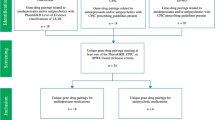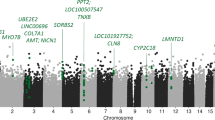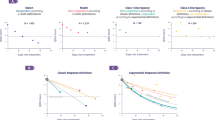Abstract
Personalized medication that is based on pharmacogenetic data has long been expected to improve the efficacy of treatments for neurological and psychiatric disorders, including depression. However, the complexity of the regulation of gene transcription and its interactions with environmental factors means that straightforward translation of individual genetic information into tailored treatment is unlikely. Nevertheless, when data from genomics, proteomics, metabolomics, neuroimaging and neuroendocrinology are used in combination, they could lead to the development of effective personalized antidepressant treatment that is based on both genotypes and biomarkers. This process will require many further steps and collaboration between basic and clinical neuroscience.
This is a preview of subscription content, access via your institution
Access options
Subscribe to this journal
Receive 12 print issues and online access
$189.00 per year
only $15.75 per issue
Buy this article
- Purchase on Springer Link
- Instant access to full article PDF
Prices may be subject to local taxes which are calculated during checkout


Similar content being viewed by others
References
Roses, A. D. Genome-based pharmacogenetics and the pharmaceutical industry. Nature Rev. Drug Discov. 1, 541–549 (2002).
Roses, A. D. Pharmacogenetics and the practice of medicine. Nature 405, 857–865 (2000).
Binder, E. B. & Holsboer, F. Pharmacogenomics and antidepressant drugs. Ann. Med. 38, 82–94 (2006).
Perlis, R. H. et al. Association between treatment-emergent suicidal ideation with citalopram and polymorphisms near cyclic adenosine monophosphate response element binding protein in the STAR*D study. Arch. Gen. Psychiatry 64, 689–697 (2007).
Serretti, A., Drago, A. & De, R. D. HTR2A gene variants and psychiatric disorders: a review of current literature and selection of SNPs for future studies. Curr. Med. Chem. 14, 2053–2069 (2007).
Lesch, K. P. et al. The 5-HT transporter gene-linked polymorphic region (5-HTTLPR) in evolutionary perspective: alternative biallelic variation in rhesus monkeys. Rapid communication. J. Neural Transm. 104, 1259–1266 (1997).
Serretti, A. et al. The influence of Serotonin Transporter Promoter Polymorphism (SERTPR) and other polymorphisms of the serotonin pathway on the efficacy of antidepressant treatments. Prog. Neuropsychopharmacol. Biol. Psychiatry 29, 1074–1084 (2005).
Kraft, J. B. et al. Analysis of association between the serotonin transporter and antidepressant response in a large clinical sample. Biol. Psychiatry 61, 734–742 (2007).
Murphy, G. M. Jr et al. Effects of the serotonin transporter gene promoter polymorphism on mirtazapine and paroxetine efficacy and adverse events in geriatric major depression. Arch. Gen. Psychiatry 61, 1163–1169 (2004).
Binder, E. B. et al. Polymorphisms in FKBP5 are associated with increased recurrence of depressive episodes and rapid response to antidepressant treatment. Nature Genet. 36, 1319–1325 (2004).
Lekman, M. et al. The FKBP5-gene in depression and treatment response—an association study in the Sequenced Treatment Alternatives to Relieve Depression (STAR*D) cohort. Biol. Psychiatry 63, 1103–1110 (2008).
Kirchheiner, J. F. et al. Pharmacogenetics of antidepressants and antipsychotics: the contribution of allelic variations to the phenotype of drug response. Mol. Psychiatry 9, 442–473 (2004).
Li, J. Y., Boado, R. J. & Pardridge, W. M. Blood–brain barrier genomics. J. Cereb. Blood Flow Metab. 21, 61–68 (2001).
Uhr, M. F. et al. Polymorphisms in the drug transporter gene ABCB1 predict antidepressant treatment response in depression. Neuron 57, 203–209 (2008).
Birney, E. et al. Identification and analysis of functional elements in 1% of the human genome by the ENCODE pilot project. Nature 447, 799–816 (2007).
Carmell, M. A., Xuan, Z., Zhang, M. Q. & Hannon, G. J. The Argonaute family: tentacles that reach into RNAi, developmental control, stem cell maintenance, and tumorigenesis. Genes Dev. 16, 2733–2742 (2002).
Vasudevan, S., Tong, Y. & Steitz, J. A. Switching from repression to activation: microRNAs can up-regulate translation. Science 318, 1931–1934 (2007).
Greco, S. J. & Rameshwar, P. MicroRNAs regulate synthesis of the neurotransmitter substance P in human mesenchymal stem cell-derived neuronal cells. Proc. Natl Acad. Sci. USA 104, 15484–15489 (2007).
Fire, A. et al. Potent and specific genetic interference by double-stranded RNA in Caenorhabditis elegans. Nature 391, 806–811 (1998).
Elbashir, S. M. et al. Duplexes of 21-nucleotide RNAs mediate RNA interference in cultured mammalian cells. Nature 411, 494–498 (2001).
Dermitzakis, E. T., Reymond, A. & Antonarakis, S. E. Conserved non-genic sequences — an unexpected feature of mammalian genomes. Nature Rev. Genet. 6, 151–157 (2005).
Nobrega, M. A., Zhu, Y., Plajzer-Frick, I., Afzal, V. & Rubin, E. M. Megabase deletions of gene deserts result in viable mice. Nature 431, 988–993 (2004).
Redon, R. F. et al. Global variation in copy number in the human genome. Nature 444, 444–454 (2006).
Hollox, E. J. et al. Psoriasis is associated with increased β-defensin genomic copy number. Nature Genet. 40, 23–25 (2008).
Mill, J. & Petronis, A. Molecular studies of major depressive disorder: the epigenetic perspective. Mol. Psychiatry 12, 799–814 (2007).
Tsankova, N., Renthal, W., Kumar, A. & Nestler, E. J. Epigenetic regulation in psychiatric disorders. Nature Rev. Neurosci. 8, 355–367 (2007).
Jenuwein, T. & Allis, C. D. Translating the histone code. Science 293, 1074–1080 (2001).
Kouzarides, T. Histone methylation in transcriptional control. Curr. Opin. Genet. Dev. 12, 198–209 (2002).
Cheung, W. L., Briggs, S. D. & Allis, C. D. Acetylation and chromosomal functions. Curr. Opin. Cell Biol. 12, 326–333 (2000).
Robzyk, K., Recht, J. & Osley, M. A. Rad6-dependent ubiquitination of histone H2B in yeast. Science 287, 501–504 (2000).
Nathan, D., Sterner, D. E. & Berger, S. L. Histone modifications: Now summoning sumoylation. Proc. Natl Acad. Sci. USA 100, 13118–13120 (2003).
Carbia-Nagashima, A. et al. RSUME, a small RWD-containing protein, enhances SUMO conjugation and stabilizes HIF-1α during hypoxia. Cell 131, 309–323 (2007).
Cheng, J., Kang, X., Zhang, S. & Yeh, E. T. SUMO-specific protease 1 is essential for stabilization of HIF1α during hypoxia. Cell 131, 584–595 (2007).
Renthal, W. et al. Histone deacetylase 5 epigenetically controls behavioral adaptations to chronic emotional stimuli. Neuron 56, 517–529 (2007).
Tsankova, N. M. et al. Sustained hippocampal chromatin regulation in a mouse model of depression and antidepressant action. Nature Neurosci. 9, 519–525 (2006).
Jaenisch, R. & Bird, A. Epigenetic regulation of gene expression: how the genome integrates intrinsic and environmental signals. Nature Genet. 33 (Suppl.), 245–254 (2003).
Weaver, I. C. et al. Reversal of maternal programming of stress responses in adult offspring through methyl supplementation: altering epigenetic marking later in life. J. Neurosci. 25, 11045–11054 (2005).
Heim, C. & Nemeroff, C. B. The role of childhood trauma in the neurobiology of mood and anxiety disorders: preclinical and clinical studies. Biol. Psychiatry 49, 1023–1039 (2001).
Fraga, M. F. et al. Epigenetic differences arise during the lifetime of monozygotic twins. Proc. Natl Acad. Sci. USA 102, 10604–10609 (2005).
Stratton, M. R. & Rahman, N. The emerging landscape of breast cancer susceptibility. Nature Genet. 40, 17–22 (2008).
Hyman, S. E. Can neuroscience be integrated into the DSM-V? Nature Rev. Neurosci. 8, 725–732 (2007).
Matigian, N. et al. Expression profiling in monozygotic twins discordant for bipolar disorder reveals dysregulation of the WNT signalling pathway. Mol. Psychiatry 12, 815–825 (2007).
Mirnics, K., Levitt, P. & Lewis, D. A. Critical appraisal of DNA microarrays in psychiatric genomics. Biol. Psychiatry 60, 163–176 (2006).
Hakonarson, H. et al. Profiling of genes expressed in peripheral blood mononuclear cells predicts glucocorticoid sensitivity in asthma patients. Proc. Natl Acad. Sci. USA 102, 14789–14794 (2005).
Holsboer, F. The corticosteroid receptor hypothesis of depression. Neuropsychopharmacology 23, 477–501 (2000).
Karssen, A. M. et al. Stress-induced changes in primate prefrontal profiles of gene expression. Mol. Psychiatry 12, 1089–1102 (2007).
Krishnan, V. et al. Molecular adaptations underlying susceptibility and resistance to social defeat in brain reward regions. Cell 131, 391–404 (2007).
Kromer, S. A. et al. Identification of glyoxalase-I as a protein marker in a mouse model of extremes in trait anxiety. J. Neurosci. 25, 4375–4384 (2005).
Hovatta, I. et al. Glyoxalase 1 and glutathione reductase 1 regulate anxiety in mice. Nature 438, 662–666 (2005).
Ditzen, C. et al. Protein biomarkers in a mouse model of extremes in trait anxiety. Mol. Cell. Proteomics 5, 1914–1920 (2006).
Weaver, I. C. et al. Epigenetic programming by maternal behavior. Nature Neurosci. 7, 847–854 (2004).
Kagan, B. L., Sultzer, D. L., Rosenlicht, N. & Gerner, R. H. Oral S-adenosylmethionine in depression: a randomized, double-blind, placebo-controlled trial. Am. J. Psychiatry 147, 591–595 (1990).
Wishart, D. S. Proteomics and the human metabolome project. Expert Rev. Proteomics 4, 333–335 (2007).
Fernie, A. R., Trethewey, R. N., Krotzky, A. J. & Willmitzer, L. Metabolite profiling: from diagnostics to systems biology. Nature Rev. Mol. Cell Biol. 5, 763–769 (2004).
Holmes, E. et al. Metabolic profiling of CSF: evidence that early intervention may impact on disease progression and outcome in schizophrenia. PLoS Med. 3, e327 (2006).
Kaddurah-Daouk, R. et al. Metabolomic mapping of atypical antipsychotic effects in schizophrenia. Mol. Psychiatry 12, 934–945 (2007).
Borsook, D., Becerra, L. & Hargreaves, R. A role for fMRI in optimizing CNS drug development. Nature Rev. Drug Discov. 5, 411–424 (2006).
Jacobs, L. D. et al. Intramuscular interferon beta-1a therapy initiated during a first demyelinating event in multiple sclerosis. CHAMPS study group. N. Engl. J. Med. 343, 898–904 (2000).
Sheline, Y. I. et al. Increased amygdala response to masked emotional faces in depressed subjects resolves with antidepressant treatment: an fMRI study. Biol. Psychiatry 50, 651–658 (2001).
Aravanis, A. M. et al. An optical neural interface: in vivo control of rodent motor cortex with integrated fiberoptic and optogenetic technology. J. Neural Eng. 4, S143–S156 (2007).
Airan, R. D. et al. High-speed imaging reveals neurophysiological links to behavior in an animal model of depression. Science 317, 819–823 (2007).
Drevets, W. C. et al. Subgenual prefrontal cortex abnormalities in mood disorders. Nature 386, 824–827 (1997).
Herrmann, W. M., Scharer, E., Wendt, G. & Delini-Stula, A. Pharmaco-EEG profile of maroxepine: third example to discuss the predictive value of pharmaco-electroencephalography in early human pharmacological evaluations of psychoactive drugs. Pharmacopsychiatry 24, 214–224 (1991).
Saletu, B. & Grunberger, J. Drug profiling by computed electroencephalography and brain maps, with special consideration of sertraline and its psychometric effects. J. Clin. Psychiatry 49 (Suppl.), 59–71 (1988).
Fu, C. H. et al. Attenuation of the neural response to sad faces in major depression by antidepressant treatment: a prospective, event-related functional magnetic resonance imaging study. Arch. Gen. Psychiatry 61, 877–889 (2004).
Hunter, A. M., Leuchter, A. F., Morgan, M. L. & Cook, I. A. Changes in brain function (quantitative EEG cordance) during placebo lead-in and treatment outcomes in clinical trials for major depression. Am. J. Psychiatry 163, 1426–1432 (2006).
Bares, M. et al. Changes in QEEG prefrontal cordance as a predictor of response to antidepressants in patients with treatment resistant depressive disorder: a pilot study. J. Psychiatr. Res. 41, 319–325 (2007).
Cook, I. A. et al. Early changes in prefrontal activity characterize clinical responders to antidepressants. Neuropsychopharmacology 27, 120–131 (2002).
Hunter, A. M., Cook, I. A. & Leuchter, A. F. The promise of the quantitative electroencephalogram as a predictor of antidepressant treatment outcomes in major depressive disorder. Psychiatr. Clin. North Am. 30, 105–124 (2007).
Lauer, C. J., Riemann, D., Wiegand, M. & Berger, M. From early to late adulthood. Changes in EEG sleep of depressed patients and healthy volunteers. Biol. Psychiatry 29, 979–993 (1991).
Hatzinger, M., Hemmeter, U. M., Brand, S., Ising, M. & Holsboer-Trachsler, E. Electroencephalographic sleep profiles in treatment course and long-term outcome of major depression: association with DEX/CRH-test response. J. Psychiatr. Res. 38, 453–465 (2004).
Nemeroff, C. B. et al. Elevated concentrations of CSF corticotropin-releasing factor-like immunoreactivity in depressed patients. Science 226, 1342–1344 (1984).
Raadsheer, F. C., Hoogendijk, W. J., Stam, F. C., Tilders, F. J. & Swaab, D. F. Increased numbers of corticotropin-releasing hormone expressing neurons in the hypothalamic paraventricular nucleus of depressed patients. Neuroendocrinology 60, 436–444 (1994).
de Kloet, E. R., Joels, M. & Holsboer, F. Stress and the brain: from adaptation to disease. Nature Rev. Neurosci. 6, 463–475 (2005).
Ising, M. et al. Combined dexamethasone/corticotropin releasing hormone test predicts treatment response in major depression–a potential biomarker? Biol. Psychiatry 62, 47–54 (2007).
Berton, O. & Nestler, E. J. New approaches to antidepressant drug discovery: beyond monoamines. Nature Rev. Neurosci. 7, 137–151 (2006).
Wong, M. L. & Licinio, J. From monoamines to genomic targets: a paradigm shift for drug discovery in depression. Nature Rev. Drug Discov. 3, 136–151 (2004).
Kitano, H. Towards a theory of biological robustness. Mol. Syst. Biol. 3, 137 (2007).
McMahon, F. J. et al. Variation in the gene encoding the serotonin 2A receptor is associated with outcome of antidepressant treatment. Am. J. Hum. Genet. 78, 804–814 (2006).
Suzuki, Y., Sawamura, K. & Someya, T. Polymorphisms in the 5-hydroxytryptamine 2A receptor and CytochromeP4502D6 genes synergistically predict fluvoxamine-induced side effects in japanese depressed patients. Neuropsychopharmacology 31, 825–831 (2006).
Sato, K. et al. Association between -1438G/A promoter polymorphism in the 5-HT2A receptor gene and fluvoxamine response in Japanese patients with major depressive disorder. Neuropsychobiology 46, 136–140 (2002).
Choi, M. J., Kang, R. H., Ham, B. J., Jeong, H. Y. & Lee, M. S. Serotonin receptor 2A gene polymorphism (-1438A/G) and short-term treatment response to citalopram. Neuropsychobiology 52, 155–162 (2005).
Peters, E. J., Slager, S. L., McGrath, P. J., Knowles, J. A. & Hamilton, S. P. Investigation of serotonin-related genes in antidepressant response. Mol. Psychiatry 9, 879–889 (2004).
Paddock, S. et al. Association of GRIK4 with outcome of antidepressant treatment in the STAR*D cohort. Am. J. Psychiatry 164, 1181–1188 (2007).
Wilkie, M. J. et al. A splice site polymorphism in the G-protein β subunit influences antidepressant efficacy in depression. Pharmacogenet. Genomics 17, 207–215 (2007).
Serretti, A. et al. SSRIs antidepressant activity is influenced by Gβ3 variants. Eur. Neuropsychopharmacol. 13, 117–122 (2003).
Zill, P. et al. Evidence for an association between a G-protein β3-gene variant with depression and response to antidepressant treatment. Neuroreport 11, 1893–1897 (2000).
Lee, H. J. et al. Association between a G-protein β3 subunit gene polymorphism and the symptomatology and treatment responses of major depressive disorders. Pharmacogenomics J. 4, 29–33 (2004).
Licinio, J. et al. Association of a corticotropin-releasing hormone receptor 1 haplotype and antidepressant treatment response in Mexican-Americans. Mol. Psychiatry 9, 1075–1082 (2004).
Liu, Z. et al. Association study of corticotropin-releasing hormone receptor1 gene polymorphisms and antidepressant response in major depressive disorders. Neurosci. Lett. 414, 155–158 (2007).
Serretti, A., Kato, M., De, R. D. & Kinoshita, T. Meta-analysis of serotonin transporter gene promoter polymorphism (5-HTTLPR) association with selective serotonin reuptake inhibitor efficacy in depressed patients. Mol. Psychiatry 12, 247–257 (2007).
Kang, R. H., Wong, M. L., Choi, M. J., Paik, J. W. & Lee, M. S. Association study of the serotonin transporter promoter polymorphism and mirtazapine antidepressant response in major depressive disorder. Prog. Neuropsychopharmacol. Biol. Psychiatry 31, 1317–1321 (2007).
Hong, C. J., Chen, T. J., Yu, Y. W. & Tsai, S. J. Response to fluoxetine and serotonin 1A receptor (C-1019G) polymorphism in Taiwan Chinese major depressive disorder. Pharmacogenomics J. 6, 27–33 (2006).
Yu, Y. W., Tsai, S. J., Liou, Y. J., Hong, C. J. & Chen, T. J. Association study of two serotonin 1A receptor gene polymorphisms and fluoxetine treatment response in Chinese major depressive disorders. Eur. Neuropsychopharmacol. 16, 498–503 (2006).
Lemonde, S., Du, L., Bakish, D., Hrdina, P. & Albert, P. R. Association of the C(-1019)G 5-HT1A functional promoter polymorphism with antidepressant response. Int. J. Neuropsychopharmacol. 7, 501–506 (2004).
Serretti, A. et al. The C(-1019)G polymorphism of the 5-HT1A gene promoter and antidepressant response in mood disorders: preliminary findings. Int. J. Neuropsychopharmacol. 7, 453–460 (2004).
Suzuki, Y., Sawamura, K. & Someya, T. The effects of a 5-hydroxytryptamine 1A receptor gene polymorphism on the clinical response to fluvoxamine in depressed patients. Pharmacogenomics. J. 4, 283–286 (2004).
Arias, B. et al. Analysis of COMT gene (Val 158 Met polymorphism) in the clinical response to SSRIs in depressive patients of European origin. J. Affect. Disord. 90, 251–256 (2006).
Szegedi, A. et al. The catechol-O-methyltransferase Val108/158Met polymorphism affects short-term treatment response to mirtazapine, but not to paroxetine in major depression. Pharmacogenomics. J. 5, 49–53 (2005).
Baune, B. T. et al. Association of the COMT val158met variant with antidepressant treatment response in major depression. Neuropsychopharmacology 33, 924–932 (2007).
Yu, Y. W. et al. Association study of a monoamine oxidase A gene promoter polymorphism with major depressive disorder and antidepressant response. Neuropsychopharmacology 30, 1719–1723 (2005).
Domschke, K. et al. Monoamine oxidase A variant influences antidepressant treatment response in female patients with Major Depression. Prog. Neuropsychopharmacol. Biol. Psychiatry 32, 224–228 (2007).
Acknowledgements
The author's research on personalized medicine is supported by the Max Planck Excellence Foundation.
Author information
Authors and Affiliations
Related links
Rights and permissions
About this article
Cite this article
Holsboer, F. How can we realize the promise of personalized antidepressant medicines?. Nat Rev Neurosci 9, 638–646 (2008). https://doi.org/10.1038/nrn2453
Published:
Issue Date:
DOI: https://doi.org/10.1038/nrn2453
This article is cited by
-
Differential effects of healthcare worker burnout on psychotropic medication use and misuse by occupational level
Social Psychiatry and Psychiatric Epidemiology (2023)
-
ABCB1 variants and sex affect serotonin transporter occupancy in the brain
Molecular Psychiatry (2022)
-
A pilot exploration of multi-omics research of gut microbiome in major depressive disorders
Translational Psychiatry (2022)
-
Targeted exome sequencing identifies five novel loci at genome-wide significance for modulating antidepressant response in patients with major depressive disorder
Translational Psychiatry (2020)
-
Neuropathology of Kynurenine Pathway of Tryptophan Metabolism
Current Pharmacology Reports (2020)



